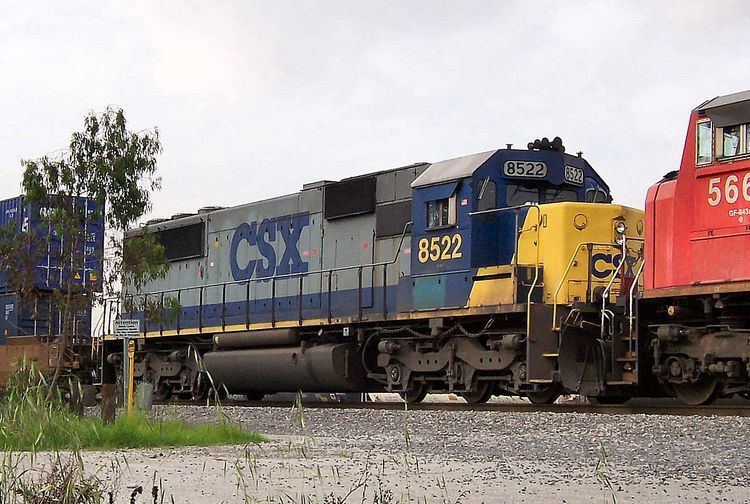Power type Diesel-electric | Total produced 427 | |
 | ||
Build date December 1980 – July 1987 Gauge 4 ft 8 ⁄2 in (1,435 mm) standard gauge Length 71 ft 2 in (21.69 m) over the coupler pulling faces | ||
The EMD SD50 is a 3,500-horsepower (2,610 kW) diesel-electric locomotive built by General Motors Electro-Motive Division. It was introduced in May 1981 as part of EMD's "50 Series", but prototype SD50S locomotives were built from 1980; production ceased in January 1986. The SD50 was in many respects a transitional model between EMD's Dash 2 series which was produced throughout the 1970s and the microprocessor-equipped SD60 and SD70 locomotives.
Contents
History
The SD50 was produced in response to increasingly tough competition from GE Transportation Systems, whose Dash 7 line was proving quite successful with railroads. While EMD's SD40-2 was a reliable and trusted product, GE's line included locomotives up to 3,600 hp (2,685 kW) with more modern technology, as well as very competitive finance and maintenance deals. EMD responded throughout the SD50 program by offering discounts on large orders.
GM-EMD had previously produced 3,600 hp (2,685 kW) locomotives, the SD45 and later SD45-2, but these used huge, 20-cylinder engines with high fuel consumption, and had reliability problems when first introduced. Demand for the 45 series dropped sharply after the 1970s fuel crisis. The SD50 used an updated version of the V16 645 used in the SD40-2, uprated to 3,500 hp (2,600 kW)- and later 3,600 hp (2,685 kW) - at 950 rpm from 3,000 hp (2,240 kW) at 900 rpm. This proved to be a step too far; the 50 series models were plagued by engine and electrical system problems which harmed both sales and the reputation of EMD.
The subsequent SD60 model replaced the overstressed 950-rpm 645F engine with a new engine series, the 900-rpm 710G.
The SD50's long hood saw changes from previous EMD models. The overall frame length was increased, and the long hood was made substantially longer. The resistors for the dynamic brake grid were moved from their previous location above the prime mover to a new, cooler location in front of the engine compartment air intakes, where they were more effectively separated from the rest of the locomotives' systems, and also closer to the locomotive's electrical switchgear, thereby simplifying the prime mover maintenance procedures, and the electrical system as well.
Technical
The SD50 is powered by V16 16-645F3 series diesel engine driving either an EMD AR11A-D14 or an EMD AR16A-D18 traction alternator. The power generated by the traction alternator drove 6 EMD D87 traction motors rated at 1170 amps each.
Depending on customer options, the SD50 was available with a multitude of traction-motor gearing ratio and wheel size options, the most common of which being the 70:17 ratio with 40-inch (1,016 mm) wheels, this allowed for a top speed of 70 mph (110 km/h). Other gearing options for the SD50 with 40-inch (1,016 mm) wheels include 69:18 for 76 mph (122 km/h), 67:19 for 82 mph (132 km/h) and 66:20 for 88 mph (142 km/h). 42-inch (1,067 mm) wheels were also available. Customers of the SD50 also had the option of either HT-C trucks (identified with a hydraulic shock on the side of the middle axle of each truck) or the earlier Flexicoil trucks, which only Conrail opted for. Some investigators implicated the HT-C truck in derailments in Amtrak's SDP40F locomotive fleet and Conrail chose to order SD40-2s and their first order of SD50s with the earlier Flexicoil C truck. The controversy surrounding the HT-C truck was eventually disproved, and Conrail's second order of SD50s as well as their SD60 variants were all HT-C equipped.
The SD50 could be equipped with fuel tanks sizes from 3,200 US gallons (12,100 l; 2,660 imp gal) up to 4,400 US gallons (16,700 l; 3,660 imp gal), had a lube oil capacity of 396 US gallons (1,500 l; 330 imp gal) and a cooling water capacity of 276 US gallons (1,040 l; 230 imp gal).
SD50S
The SD50S ("short frame") were prototype units built in December 1980. They were shorter than production locomotives by approximately 2 feet (0.61 m). There were 6 SD50S ever built, and all of these prototypes were sold to the Norfolk & Western and passed to the Norfolk Southern; they were withdrawn in the early 2000s as non-standard. Two were rebuilt in 2008 as "SD40E" models by Norfolk Southern's Juniata Shops, along with several standard length SD50's.
The designation also applies to five locomotives built by EMD Australian licensee Clyde Engineering, Adelaide for Hamersley Iron. These were shorter than production SD50s, and were equipped with a special double cab roof for insulation against the hot Australian desert sun in the Pilbara region. Withdrawn in November 1995, they were sold to National Railway Equipment Company and exported to the U.S. in February 1999 and used in national lease service. They were subsequently sold to the Utah Railway in June 2001, where they remain.
SD50F
The SD50F was a Canadian cowl unit version equipped with a "Draper taper" (inset section aft of cab for limited rear visibility). 60 were built for the Canadian National Railway as road numbers 5400-5459. Early engine problems resulted in a temporary down-rating to 3,300 horsepower (2,500 kW). Eventually the units were re-rated to 3,500 horsepower (2,600 kW); however, like their U.S. cousins, they continued to suffer from relatively low reliability, frequently suffering engine, power assembly, and crankshaft failures.
Out of the 60, only six of these locomotives are known to exist today, with the rest of the fleet scrapped.
Current owners
As of 2008, current owners and operators include:
Rebuilds
A number of SD50s have been rebuilt into the equivalent of SD40-2s. The Dash 2 features are already contained within the SD50. The units are re-rated from 3,500 hp (2,600 kW) at 950 rpm to 3,000 hp (2,200 kW) at 900 rpm. This is actually a quite simple change to the locomotive's Woodward PGE engine governor.
